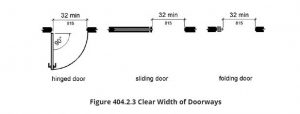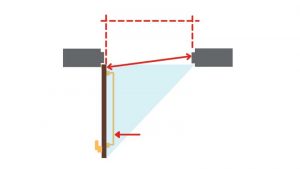Door Opening Clearance
Door opening clearance is also a key consideration in meeting ADAAG standards. According to 404.2.3, those doorways shall have a minimum clear opening width of 815 mm (32 in.) with the door open 90 degrees, measured between the face of the door and the opposite stop (see Figure 6).

The clearance at the open edge of a doorway shall allow passage without hitting either a fixed object or an obstruction. The clearance at the open edge of a doorway should be no less than 865 mm (34 in.) and not greater than 2030 mm (80 in.) (see Figure 7).
This measurement often gets miscalculated because it is often assumed if an 815 mm door is installed, the specification has been met. This is not the case, however, because the measurement needs to be from the inside—from the hinges to the latch.
This is also a common error in designing sliding doors as the 815 mm requirement applies to these doors also, but the surface mounted hardware will not allow the door to completely slide into the wall (pocket door) or past the wall (barn door/bypassing door).
The U.S. Access Board recommends 38 mm (1.5 in.) clearances around the door pull, which (when added to the size of the pull) reduces the clear opening width by a significant amount (i.e. 38 mm clearance plus 25.5 mm [1 in.] pull diameter plus 38 mm clearance equals 102 mm [4 in.]). This would mean a 915 mm sliding door may meet the 815 mm clearance, but all products would have zero tolerance for installation. Often, these doors are made larger to eliminate sight lines causing additional issues for meeting the clear opening width. It is best practice that sliding doors be made 1065 mm wide to avoid these issues.

The door opening must be at least 815 mm. From the door to the stop is an important measurement because someone in a wheelchair needs to be able to pass through.
Doors in a Series
When there are two or more doors in a series, the minimum space between two hinged or pivoted doors must be 1220 mm plus the width of any swinging door into the space. This concept is illustrated in Figure 8:
• (A) the doors swing in the same direction;
• (B) the two doors swing away from each other; or
• (C) the two doors swing toward each other.
In any case, the measurement of 1220 mm is required. It begins with the wall’s edge or leading edge of the door and is measured to the opposite wall’s edge or leading edge of the door. This is another important measurement to ensure accessibility requirements are met.
Additionally, the door size must be considered and added in with the minimum requirement of 1220 mm for the total required dimensions. In Figure 8, Diagram A, the doors are 915 mm; the corridor with two doors swinging in the same direction must be 2.1 m (7 ft) (915 mm for the door, plus a minimum of 1220 mm between doors equals 2135 mm [84 in.]).
In accordance with ADAAG 404.2.6, Doors in Series and Gates in Series, if the doors swing in the opposite direction, as in Figure 8, Diagram B, the measurement is the minimum 1220 mm. For Diagram C, because the doors swing into the same space, the dimensions of both doors must be considered and added to the minimum requirement for maneuverability of 914 mm for Door A, plus 1220 mm for the corridor plus 914 mm for Door B, equaling 3 m (10 ft).




